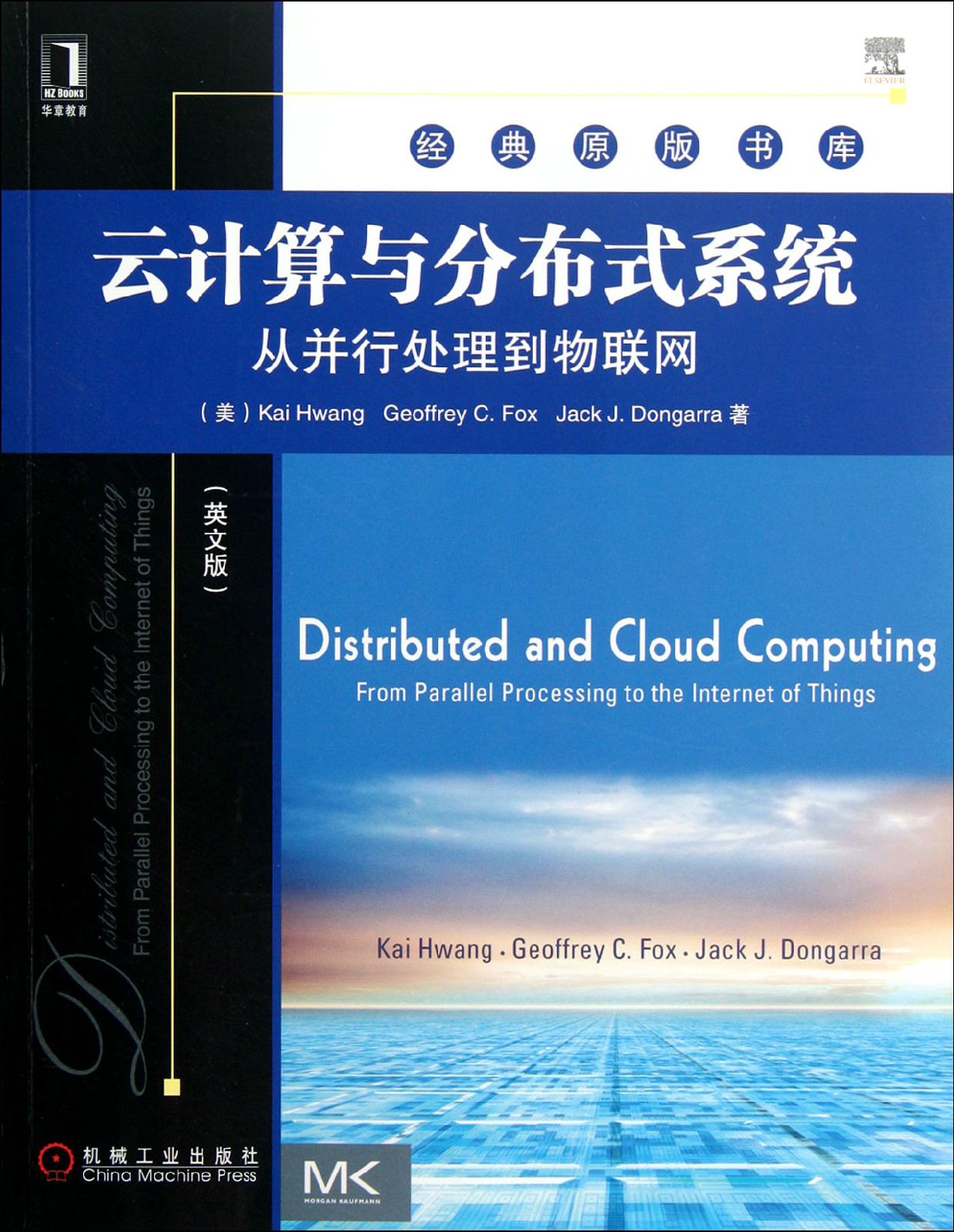編輯推薦
“格線計算、
對等計算、雲計算這些新興領域近幾年日益受到學術界和工業界的關注。預計這些新技術將對商業、科學和工程及社會等眾多方面產生巨大影響。本書的及時出版將會幫助讀者了解分散式計算領域的最新技術。”
——ThomasJ.Hacker,普度大學
“你是學
分散式系統或分散式計算課程的學生嗎?如果是,那么這本書是你的最佳選擇。本書作者做了一個傑出的工作,在書中講述了在硬體和軟體、
系統體系結構、新的編程範式和生態系統方面的最新進展,既關注速度和性能最佳化,又考慮能源效率與節能。
作者首先評價了過去30年計算和IT趨勢中的演變,並討論了
集群計算系統和大規模並行處理器。接著,針對雲計算套用,他們介紹了
虛擬機、虛擬機線上遷移、虛擬集群構建、資源供應、虛擬配置適配和
虛擬數據中心設計。然後,作者介紹了雲體系結構和數據中心設計的設計原理與使能技術,探究了兩種主要的分散式服務(REST和Web服務)以及Web服務在格線系統中的擴展。此外,作者還介紹了主要的雲編程範式:
MapReduce、
BigTable、Twister、
Dryad、
DryadLINQ、Hadoop、Sawal和PigLatin。而且書中還介紹了計算/數據格線中的設計原理、平台體系結構、中間件支持、資源管理和服務標準。之後,作者描述了非結構化、結構化和混合式覆蓋網路。最後,他們檢測了IBM、
Salesforce、SGI、Manijarsoft、
NASA和CERN構建的一些公有雲和私有雲。”
本書的目的是將傳統的多處理器和多
計算機集群轉換成Web規模格線、雲。也許更重要的是,本書關注未來網際網路中廣泛在使用的
對等網路,以及快速發展的大型
社會網路和物聯網。
——摘自Amazon讀者評論
內容簡介
隨著信息技術的廣泛套用和快速發展,雲計算作為一種新興的商業計算模型日益受到人們的廣泛關注。本書是一本完整講述雲計算與分散式系統基本理論及其套用的教材。書中從現代分散式模型概述開始,介紹了並行、分散式與雲計算系統的設計原理、
系統體系結構和創新套用,並通過開源套用和商業套用例子,闡述了如何為科研、電子商務、
社會網路和超級計算等創建高性能、可擴展的、可靠的系統。
【本書特色】
提供的案例研究來自主流分散式計算供應商,如亞馬遜、微軟、谷歌等。
解釋如何利用虛擬化來促進管理、調試、遷移和災難恢復。
專為本科生或研究生的
分散式系統課程而設計——每章後都配有習題和進一步閱讀建議,並為教師提供配套的PPT等教輔資源。
作者簡介
KaiHwang(
黃鎧)美國南加州大學
電子工程與計算機科學教授,網際網路/雲計算研究實驗室主任;清華大學IV客座講席教授;IEEE終身會士。他擁有加州大學伯克利分校
EECS博士學位,主要研究領域為雲計算、
分散式系統、
高性能計算、
普適計算、信任格線計算等。現已發表論文220多篇,出版8本
計算機體系結構、數字運算、並行處理、分散式系統、
網際網路安全和雲計算方面的相關著作。他還創建了《theJournalofParallelandDistributedComputing》,並獲得了
中國計算機學會2004傑出成就獎、IEEE2011IPDPS創立者獎。
GeoffreyFox美國
印第安那大學計算機科學、信息與物理學傑出教授,社會格線實驗室主任。之前曾在加州理工和錫拉丘茲大學任教,並領導多個研究組。他擁有英國劍橋大學的博士學位。Fox在並行體系結構、分散式編程、格線計算、Web服務和網際網路套用方面做了廣泛的工作並發表了大量作品。
JackDongarra美國
田納西大學電子工程與計算機科學傑出教授,
橡樹嶺國家實驗室傑出研究員,
曼徹斯特大學TurningFellow。他是ACM/IEEE/
SIAM/AAAS會士,是超級計算機基準測試、數值分析、線性代數解算器和
高性能計算領域的先驅。多年以來,他都在負責
Top500最快計算機的Linpack基準測試評估。基於他在超級計算和高性能領域的巨大貢獻,他被評為美國國家工程院院士。
目錄
Contents
Preface.............................. vii
AbouttheAuthors..
PART1SYSTEMSMODELING,CLUSTERING,
ANDVIRTUALIZATION1
CHAPTER1DistributedSystemModelsandEnablingTechnologies...... ............3
Summary.................4
1.1ScalableComputingovertheInternet.................4
1.1.1TheAgeofInternetComputing...............4
1.1.2ScalableComputingTrendsandNewParadigms..........8
1.1.3TheInternetofThingsandCyber-PhysicalSystems......11
1.2TechnologiesforNetwork-BasedSystems................13
1.2.1MulticoreCPUsandMultithreadingTechnologies........14
1.2.2GPUComputingtoExascaleandBeyond...............17
1.2.3Memory,Storage,andWide-AreaNetworking...........20
1.2.4VirtualMachinesandVirtualizationMiddleware.........22
1.2.5DataCenterVirtualizationforCloudComputing.........25
1.3SystemModelsforDistributedandCloudComputing....27
1.3.1ClustersofCooperativeComputers.............28
1.3.2GridComputingInfrastructures...............29
1.3.3Peer-to-PeerNetworkFamilies...............32
1.3.4CloudComputingovertheInternet..............34
1.4SoftwareEnvironmentsforDistributedSystemsandClouds.... ..........36
1.4.1Service-OrientedArchitecture(SOA)...................37
1.4.2TrendstowardDistributedOperatingSystems............40
1.4.3ParallelandDistributedProgrammingModels...........42
1.5Performance,Security,andEnergyEfficiency............44
1.5.1PerformanceMetricsandScalabilityAnalysis............45
1.5.2FaultToleranceandSystemAvailability................48
1.5.3NetworkThreatsandDataIntegrity............49
1.5.4EnergyEfficiencyinDistributedComputing.............51
1.6BibliographicNotesandHomeworkProblems............55
Acknowledgments.......56
References..............56
HomeworkProblems....58
Foreword.........v
......................x
CHAPTER2ComputerClustersforScalableParallelComputing.....65
Summary...............66
2.1ClusteringforMassiveParallelism................66
2.1.1ClusterDevelopmentTrends................66
2.1.2DesignObjectivesofComputerClusters................68
2.1.3FundamentalClusterDesignIssues................69
2.1.4AnalysisoftheTop500Supercomputers................71
2.2ComputerClustersandMPPArchitectures...............75
2.2.1ClusterOrganizationandResourceSharing..............76
2.2.2NodeArchitecturesandMPPPackaging................77
2.2.3ClusterSystemInterconnects................80
2.2.4Hardware,Software,andMiddlewareSupport...........83
2.2.5GPUClustersforMassiveParallelism......... ..83
2.3DesignPrinciplesofComputerClusters.............. 87
2.3.1Single-SystemImageFeatures...............87
2.3.2HighAvailabilitythroughRedundancy..................95
2.3.3Fault-TolerantClusterConfigurations................ 99
2.3.4CheckpointingandRecoveryTechniques...............101
2.4ClusterJobandResourceManagement.................104
2.4.1ClusterJobSchedulingMethods................... 104
2.4.2ClusterJobManagementSystems...................107
2.4.3LoadSharingFacility(LSF)forClusterComputing.....109
2.4.4MOSIX:AnOSforLinuxClustersandClouds.........110
2.5CaseStudiesofTopSupercomputerSystems............112
2.5.1Tianhe-1A:TheWorldFastestSupercomputerin2010......... ....112
2.5.2CrayXT5Jaguar:TheTopSupercomputerin2009.....116
2.5.3IBMRoadrunner:TheTopSupercomputerin2008......119
2.6BibliographicNotesandHomeworkProblems..........120
Acknowledgments......121
References.............121
HomeworkProblems.........................122
CHAPTER3VirtualMachinesandVirtualizationofClustersandDataCenters...........129
Summary..............130
3.1ImplementationLevelsofVirtualization.................130
3.1.1LevelsofVirtualizationImplementation.............130
3.1.2VMMDesignRequirementsandProviders.............133
3.1.3VirtualizationSupportattheOSLevel............. 135
3.1.4MiddlewareSupportforVirtualization............. 138
3.2VirtualizationStructures/ToolsandMechanisms.........140
3.2.1HypervisorandXenArchitecture..................140
3.2.2BinaryTranslationwithFullVirtualization.............141
3.2.3Para-VirtualizationwithCompilerSupport.............143
xiiContents
3.3VirtualizationofCPU,Memory,andI/ODevices.......145
3.3.1HardwareSupportforVirtualization................ 145
3.3.2CPUVirtualization........................147
3.3.3MemoryVirtualization.....................148
3.3.4I/OVirtualization.........................150
3.3.5VirtualizationinMulti-CoreProcessors............. 153
3.4VirtualClustersandResourceManagement.............155
3.4.1PhysicalversusVirtualClusters................. ..156
3.4.2LiveVMMigrationStepsandPerformanceEffects......159
3.4.3MigrationofMemory,Files,andNetworkResources....162
3.4.4DynamicDeploymentofVirtualClusters..............165
3.5VirtualizationforData-CenterAutomation..............169
3.5.1ServerConsolidationinDataCenters..............169
3.5.2VirtualStorageManagement...............171
3.5.3CloudOSforVirtualizedDataCenters................172
3.5.4TrustManagementinVirtualizedDataCenters.........176
3.6BibliographicNotesandHomeworkProblems..........179
Acknowledgments......179
References.............180
HomeworkProblems.........................183
PART2COMPUTINGCLOUDS,SERVICE-ORIENTED
ARCHITECTURE,ANDPROGRAMMING189
CHAPTER4CloudPlatformArchitectureoverVirtualizedDataCenters. .............191
Summary..............192
4.1CloudComputingandServiceModels..................192
4.1.1Public,Private,andHybridClouds.............. 192
4.1.2CloudEcosystemandEnablingTechnologies...........196
4.1.3Infrastructure-as-a-Service(IaaS)............... ..200
4.1.4Platform-as-a-Service(PaaS)andSoftware-as-a-Service(
SaaS)... ............203
4.2Data-CenterDesignandInterconnectionNetworks......206
4.2.1Warehouse-ScaleData-CenterDesign..................206
4.2.2Data-CenterInterconnectionNetworks.................208
4.2.3ModularDataCenterinShippingContainers...........211
4.2.4InterconnectionofModularDataCenters...............212
4.2.5Data-CenterManagementIssues....................213
4.3ArchitecturalDesignofComputeandStorageClouds... ............215
4.3.1AGenericCloudArchitectureDesign.................215
4.3.2LayeredCloudArchitecturalDevelopment.............218
4.3.3VirtualizationSupportandDisasterRecovery...........221
4.3.4ArchitecturalDesignChallenges................... 225
Contentsxiii
4.4PublicCloudPlatforms:
GAE,AWS,andAzure........227
4.4.1PublicCloudsandServiceOfferings..................227
4.4.2GoogleAppEngine(GAE)................229
4.4.3AmazonWebServices(AWS)..................... 231
4.4.4MicrosoftWindowsAzure.................233
4.5Inter-cloudResourceManagement...................234
4.5.1ExtendedCloudComputingServices..................235
4.5.2ResourceProvisioningandPlatformDeployment........237
4.5.3VirtualMachineCreationandManagement............243
4.5.4GlobalExchangeofCloudResources..................246
4.6CloudSecurityandTrustManagement..................249
4.6.1CloudSecurityDefenseStrategies.................. 249
4.6.2DistributedIntrusion/AnomalyDetection...............253
4.6.3DataandSoftwareProtectionTechniques..............255
4.6.4Reputation-GuidedProtectionofDataCenters..........257
4.7BibliographicNotesandHomeworkProblems..........261
Acknowledgements.....261
References.............261
HomeworkProblems.........................265
CHAPTER5Service-OrientedArchitecturesforDistributedComputing ..............271
Summary..............272
5.1ServicesandService-OrientedArchitecture..............272
5.1.1RESTandSystemsofSystems.....................273
5.1.2ServicesandWebServices.................277
5.1.3EnterpriseMultitierArchitecture..................282
5.1.4GridServicesandOGSA..................283
5.1.5OtherService-OrientedArchitecturesandSystems.......287
5.2Message-OrientedMiddleware................289
5.2.1EnterpriseBus......289
5.2.2Publish-SubscribeModelandNotification..............291
5.2.3QueuingandMessagingSystems.....................291
5.2.4CloudorGridMiddlewareApplications...............291
5.3PortalsandScienceGateways................294
5.3.1ScienceGatewayExemplars................295
5.3.2HUBzeroPlatformforScientificCollaboration..........297
5.3.3OpenGatewayComputingEnvironments(OGCE)......301
5.4Discovery,Registries,Metadata,andDatabases.........304
5.4.1UDDIandServiceRegistries...............304
5.4.2DatabasesandPublish-Subscribe................307
5.4.3MetadataCatalogs........................308
5.4.4SemanticWebandGrid...................309
5.4.5JobExecutionEnvironmentsandMonitoring...........312
xivContents
5.5WorkflowinService-OrientedArchitectures.............314
5.5.1BasicWorkflowConcepts..................315
5.5.2WorkflowStandards.......................316
5.5.3WorkflowArchitectureandSpecification...............317
5.5.4WorkflowExecutionEngine................319
5.5.5ScriptingWorkflowSystemSwift.....................321
5.6BibliographicNotesandHomeworkProblems..........322
Acknowledgements.....324
References.............324
HomeworkProblems.........................331
CHAPTER6CloudProgrammingandSoftwareEnvironments.......335
Summary..............336
6.1FeaturesofCloudandGridPlatforms..............336
6.1.1CloudCapabilitiesandPlatformFeatures..............336
6.1.2TraditionalFeaturesCommontoGridsandClouds......336
6.1.3DataFeaturesandDatabases...............340
6.1.4ProgrammingandRuntimeSupport...................341
6.2ParallelandDistributedProgrammingParadigms........343
6.2.1ParallelComputingandProgrammingParadigms........344
6.2.2MapReduce,Twister,andIterativeMapReduce.........345
6.2.3HadoopLibraryfromApache....................355
6.2.4DryadandDryadLINQfromMicrosoft................359
6.2.5SawzallandPigLatinHigh-LevelLanguages...........365
6.2.6MappingApplicationstoParallelandDistributedSystems...... .........368
6.3ProgrammingSupportofGoogleAppEngine...........370
6.3.1ProgrammingtheGoogleAppEngine.................370
6.3.2GoogleFileSystem(
GFS).................373
6.3.3BigTable,Google’sNOSQLSystem...................376
6.3.4Chubby,Google’sDistributedLockService............379
6.4ProgrammingonAmazonAWSandMicrosoftAzure............ .....379
6.4.1ProgrammingonAmazonEC2....................380
6.4.2AmazonSimpleStorageService(S3)..................382
6.4.3AmazonElasticBlockStore(EBS)andSimpleDB......383
6.4.4MicrosoftAzureProgrammingSupport................384
6.5EmergingCloudSoftwareEnvironments................387
6.5.1OpenSourceEucalyptusandNimbus..................387
6.5.2OpenNebula,Sector/Sphere,andOpenStack............389
6.5.3ManjrasoftAnekaCloudandAppliances...............393
6.6BibliographicNotesandHomeworkProblems..........399
Acknowledgement.....399
References.............399
HomeworkProblems.........................405
Contentsxv
PART3GRIDS,P2P,ANDTHEFUTUREINTERNET413
CHAPTER7GridComputingSystemsandResourceManagement................415
Summary..............416
7.1GridArchitectureandServiceModeling................416
7.1.1GridHistoryandServiceFamilies.................416
7.1.2CPUScavengingandVirtualSupercomputers..........419
7.1.3OpenGridServicesArchitecture(
OGSA)..............422
7.1.4Data-IntensiveGridServiceModels.................425
7.2GridProjectsandGridSystemsBuilt................427
7.2.1NationalGridsandInternationalProjects...............428
7.2.2NSFTeraGridintheUnitedStates..................430
7.2.3DataGridintheEuropeanUnion................... 431
7.2.4TheChinaGridDesignExperiences...................434
7.3GridResourceManagementandBrokering..............435
7.3.1ResourceManagementandJobScheduling.............435
7.3.2GridResourceMonitoringwithCGSP.................437
7.3.3ServiceAccountingandEconomyModel..............439
7.3.4ResourceBrokeringwithGridbus................. 440
7.4SoftwareandMiddlewareforGridComputing..........443
7.4.1OpenSourceGridMiddlewarePackages...............444
7.4.2TheGlobusToolkitArchitecture(GT4)................446
7.4.3ContainersandResources/DataManagement...........450
7.4.4TheChinaGridSupportPlatform(CGSP)..............452
7.5GridApplicationTrendsandSecurityMeasures.........455
7.5.1GridApplicationsandTechnologyFusion..............456
7.5.2GridWorkloadandPerformancePrediction............457
7.5.3TrustModelsforGridSecurityEnforcement...........461
7.5.4AuthenticationandAuthorizationMethods.............464
7.5.5GridSecurityInfrastructure(GSI)..................466
7.6BibliographicNotesandHomeworkProblems..........470
Acknowledgments......471
References.............471
HomeworkProblems.........................473
CHAPTER8Peer-to-PeerComputingandOverlayNetworks........479
Summary..............480
8.1Peer-to-PeerComputingSystems...................480
8.1.1BasicConceptsofP2PComputingSystems............480
8.1.2FundamentalChallengesinP2PComputing............486
8.1.3TaxonomyofP2PNetworkSystems..................490
8.2P2POverlayNetworksandProperties..................492
8.2.1UnstructuredP2POverlayNetworks...................492
xviContents
8.2.2DistributedHashTables(DHTs)....................496
8.2.3StructuredP2POverlayNetworks.................. 498
8.2.4HierarchicallyStructuredOverlayNetworks............501
8.3Routing,Proximity,andFaultTolerance................505
8.3.1RoutinginP2POverlayNetworks....................505
8.3.2NetworkProximityinP2POverlays...................507
8.3.3FaultToleranceandFailureRecovery.................509
8.3.4ChurnResilienceagainstFailures..................512
8.4Trust,Reputation,andSecurityManagement............514
8.4.1PeerTrustandReputationSystems.................514
8.4.2TrustOverlayandDHTImplementation...............517
8.4.3PowerTrust:AScalableReputationSystem.............520
8.4.4SecuringOverlaystoPreventDDoSAttacks............522
8.5P2PFileSharingandCopyrightProtection..............523
8.5.1FastSearch,Replica,andConsistency.................524
8.5.2P2PContentDeliveryNetworks....................529
8.5.3CopyrightProtectionIssuesandSolutions..............533
8.5.4CollusivePiracyPreventioninP2PNetworks...........535
8.6BibliographicNotesandHomeworkProblems..........538
Acknowledgements.....538
References.............539
HomeworkProblems.........................541
CHAPTER9UbiquitousCloudsandtheInternetofThings.........545
Summary..............546
9.1CloudTrendsinSupportingUbiquitousComputing.....546
9.1.1UseofCloudsforHPC/HTCandUbiquitousComputing... ..........546
9.1.2Large-ScalePrivateCloudsatNASAandCERN........552
9.1.3CloudMashupsforAgilityandScalability.............555
9.1.4CloudletsforMobileCloudComputing................558
9.2PerformanceofDistributedSystemsandtheCloud......561
9.2.1ReviewofScienceandResearchClouds...............562
9.2.2Data-IntensiveScalableComputing(DISC).............566
9.2.3PerformanceMetricsforHPC/HTCSystems............568
9.2.4QualityofServiceinCloudComputing................572
9.2.5BenchmarkingMPI,Azure,EC2,
MapReduce,andHadoop.............574
9.3EnablingTechnologiesfortheInternetofThings........576
9.3.1TheInternetofThingsforUbiquitousComputing.......576
9.3.2Radio-FrequencyIdentification(RFID)................580
9.3.3SensorNetworksandZigBeeTechnology..............582
9.3.4GlobalPositioningSystem(GPS)................ 587
9.4InnovativeApplicationsoftheInternetofThings........590
9.4.1ApplicationsoftheInternetofThings.............591
Contentsxvii
9.4.2RetailingandSupply-ChainManagement..............591
9.4.3SmartPowerGridandSmartBuildings................594
9.4.4Cyber-PhysicalSystem(CPS)....................595
9.5OnlineSocialandProfessionalNetworking.............597
9.5.1OnlineSocialNetworkingCharacteristics..............597
9.5.2Graph-TheoreticAnalysisofSocialNetworks...........600
9.5.3CommunitiesandApplicationsofSocialNetworks......603
9.5.4Facebook:TheWorld’sLargestSocialNetwork........608
9.5.5TwitterforMicroblogging,News,andAlertServices....611
9.6BibliographicNotesandHomeworkProblems..........614
Acknowledgements.....614
References.............614
HomeworkProblems.........................618
Index........623

